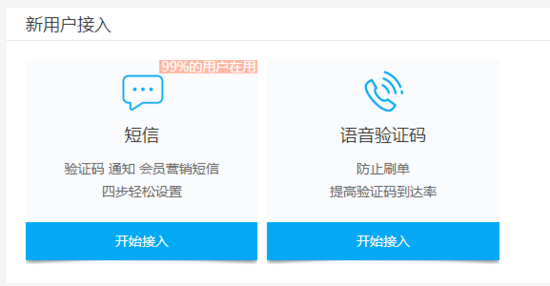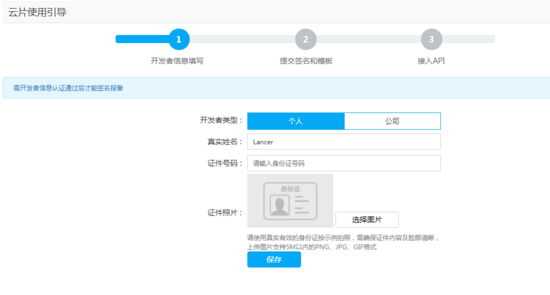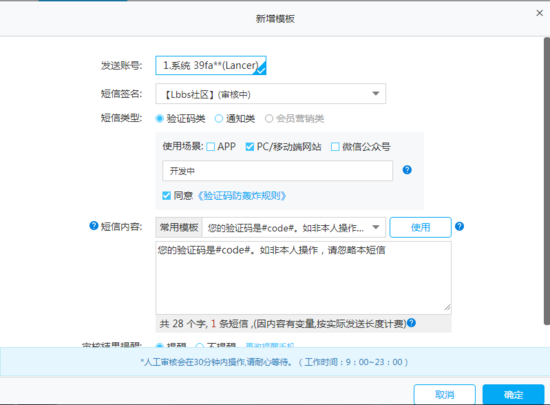正在公司做一个商城项目,由于只有一个后台,所以注册用短信注册也就轮到我来做的。刚刚开始,我内心还是有点虚的,还好有 Laravel-china 社区的 summer 大神,写的书。在里面参考了它的写法和思路,并且用了 easy-sms 包,这才用了半个下午的时间,顺利的做出来了,晚上赶紧和大家分享一波了。
1、确定短信运营商
我看到大佬都是用的云片,我也就毫不犹豫的大力推荐公司用这个短信平台了,不过其他的也可以咯。
首先自己注册一个帐号,然后找到这个

点击开始接入,完成新手引导过程。

第二部的签名和模板必须填写,类似我下面填写的这样


值得注意的是这个模板必须和你到时候用 easy-sms 包的时候,设定的短信内容必须和这个一模一样,不然会报错的。
还有就是记得一定得拿到APIKEY。到时候,在env里进行配置。
# 云片
YUNPIAN_API_KEY=9c60bdd**********
2、安装 easy-sms 包
利用这个包,可以快速的实现短信发送功能。
composer require "overtrue/easy-sms"
由于该组件还没有 Laravel 的 ServiceProvider ,为了方便使用,我们可以自己封装一下。
首先在 config 目录中增加 easysms.php 文件
在 config/easysms.php 填写如下内容。
<?php
return [
// HTTP 请求的超时时间(秒)
'timeout' => 5.0,
// 默认发送配置
'default' => [
// 网关调用策略,默认:顺序调用
'strategy' => \Overtrue\EasySms\Strategies\OrderStrategy::class,
// 默认可用的发送网关
'gateways' => [
'yunpian',
],
],
// 可用的网关配置
'gateways' => [
'errorlog' => [
'file' => '/tmp/easy-sms.log',
],
'yunpian' => [
'api_key' => env('YUNPIAN_API_KEY'),
],
],
];
然后创建一个 ServiceProvider
php artisan make:provider EasySmsServiceProvider
修改文件 app/providers/EasySmsServiceProvider.php
<?php
namespace App\Providers;
use Overtrue\EasySms\EasySms;
use Illuminate\Support\ServiceProvider;
class EasySmsServiceProvider extends ServiceProvider
{
/**
* Bootstrap the application services.
*
* @return void
*/
public function boot()
{
//
}
/**
* Register the application services.
*
* @return void
*/
public function register()
{
$this->app->singleton(EasySms::class, function ($app) {
return new EasySms(config('easysms'));
});
$this->app->alias(EasySms::class, 'easysms');
}
}
最后在 config/app.php 在 providers 里增加刚刚创建的服务写进去,App\Providers\EasySmsServiceProvider::class,
App\Providers\AppServiceProvider::class,
App\Providers\AuthServiceProvider::class,
// App\Providers\BroadcastServiceProvider::class,
App\Providers\EventServiceProvider::class,
App\Providers\RouteServiceProvider::class,
App\Providers\EasySmsServiceProvider::class, //easy-sms
3、创建路由和对应的控制器
首先创建路由,我们需要一个ajax请求短信验证码的方法,和一个进行确认注册的逻辑方法,如下:
Route::group(['prefix' => 'verificationCodes', 'as' => 'verificationCodes.'], function() {
Route::post('register', 'VerificationCodesController@register')->name('register');
Route::get('ajaxregister', 'VerificationCodesController@ajaxregister')->name('ajaxregister');
});
路由创建好了,我们用命令生成controller了
php artisan make:controller Home\VerificationCodesController
再直接在里面写 register 和 ajaxregister 方法了
代码逻辑
修改文件
app/Home/VerificationCodesController.php
<?php
.
.
.
use Overtrue\EasySms\EasySms;
use App\Models\System\User;
class VerificationCodesController extends Controller
{
// 这里验证就不写了。
public function ajaxregister(VerificationCodeRequest $request, EasySms $easySms)
{
//获取前端ajax传过来的手机号
$phone = $request->phone;
// 生成4位随机数,左侧补0
$code = str_pad(random_int(1, 9999), 4, 0, STR_PAD_LEFT);
try {
$result = $easySms->send($mobile, [
'content' => "【安拾商城】您的验证码是{$code}。如非本人操作,请忽略本短信"
]);
} catch (Overtrue\EasySms\Exceptions\NoGatewayAvailableException $exception) {
$response = $exception->getExceptions();
return response()->json($response);
}
//生成一个不重复的key 用来搭配缓存cache判断是否过期
$key = 'verificationCode_' . str_random(15);
$expiredAt = now()->addMinutes(10);
// 缓存验证码 10 分钟过期。
\Cache::put($key, ['mobile' => $mobile, 'code'=> $code], $expiredAt);
return response()->json([
'key' => $key,
'expired_at' => $expiredAt->toDateTimeString(),
], 201);
}
这样,用户就能收到短信,并且前端应该保存这个 key ,提交注册表单的时候传递给后台,判断是否已经过期。下面就是判断是否过期,验证码是否错误。
public function register(VerificationCodeRequest $request)
{
//获取刚刚缓存的验证码和key
$verifyData = \Cache::get($request->verification_key);
//如果数据不存在,说明验证码已经失效。
if(!$verifyData) {
return response()->json(['status' =>0, 'message'=> '短信验证码已失效'], 422);
}
// 检验前端传过来的验证码是否和缓存中的一致
if (!hash_equals($verifyData['code'], $request->verification_code) {
return redirect()->back()->with('warning', '短信验证码错误');
}
$user = User::create([
'mobile' => $verifyData['mobile'],
'password' => bcrypt($request->password),
]);
// 清除验证码缓存
\Cache::forget($request->verification_key);
return redirect()->route('login')->with('success', '注册成功!');
}
上面的 hash_equals 是可防止时序攻击的字符串比较的~
以上就是我整个的过程。









